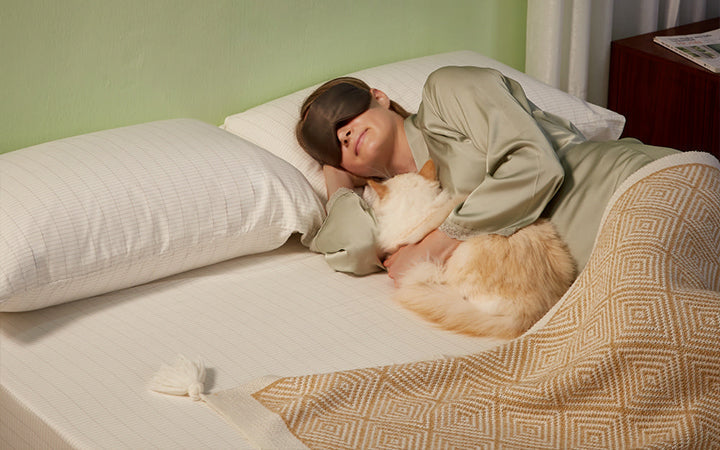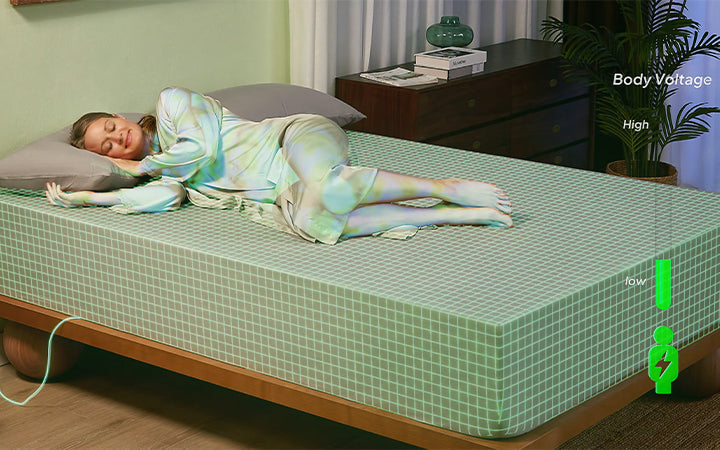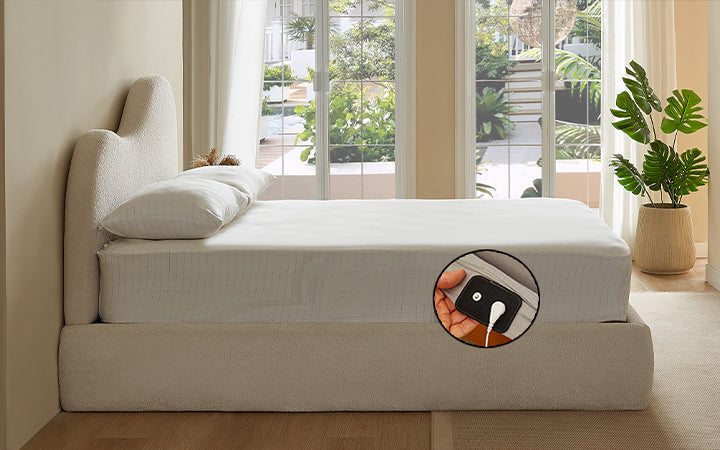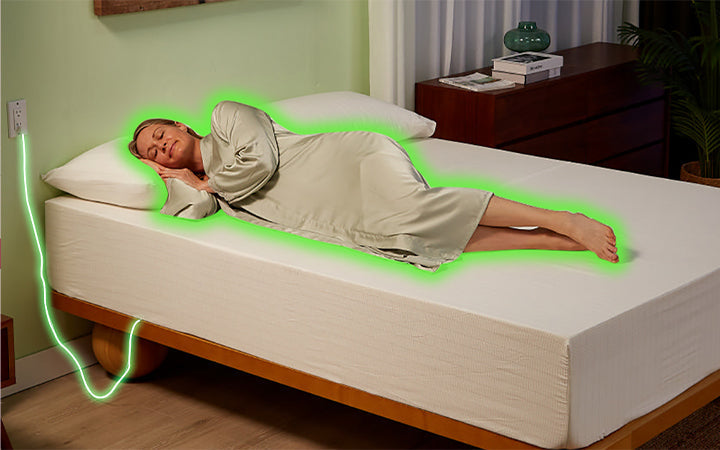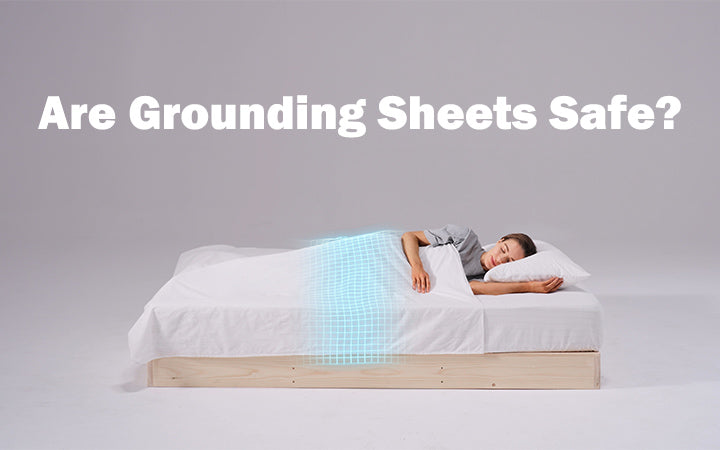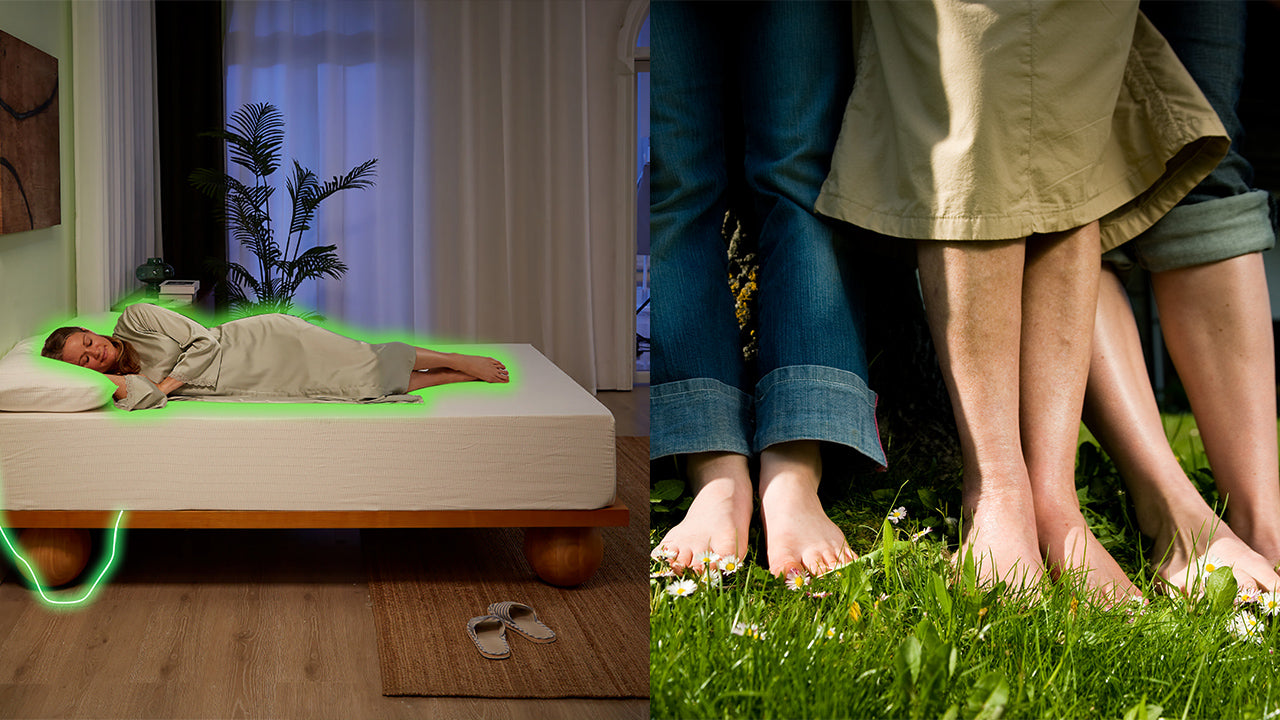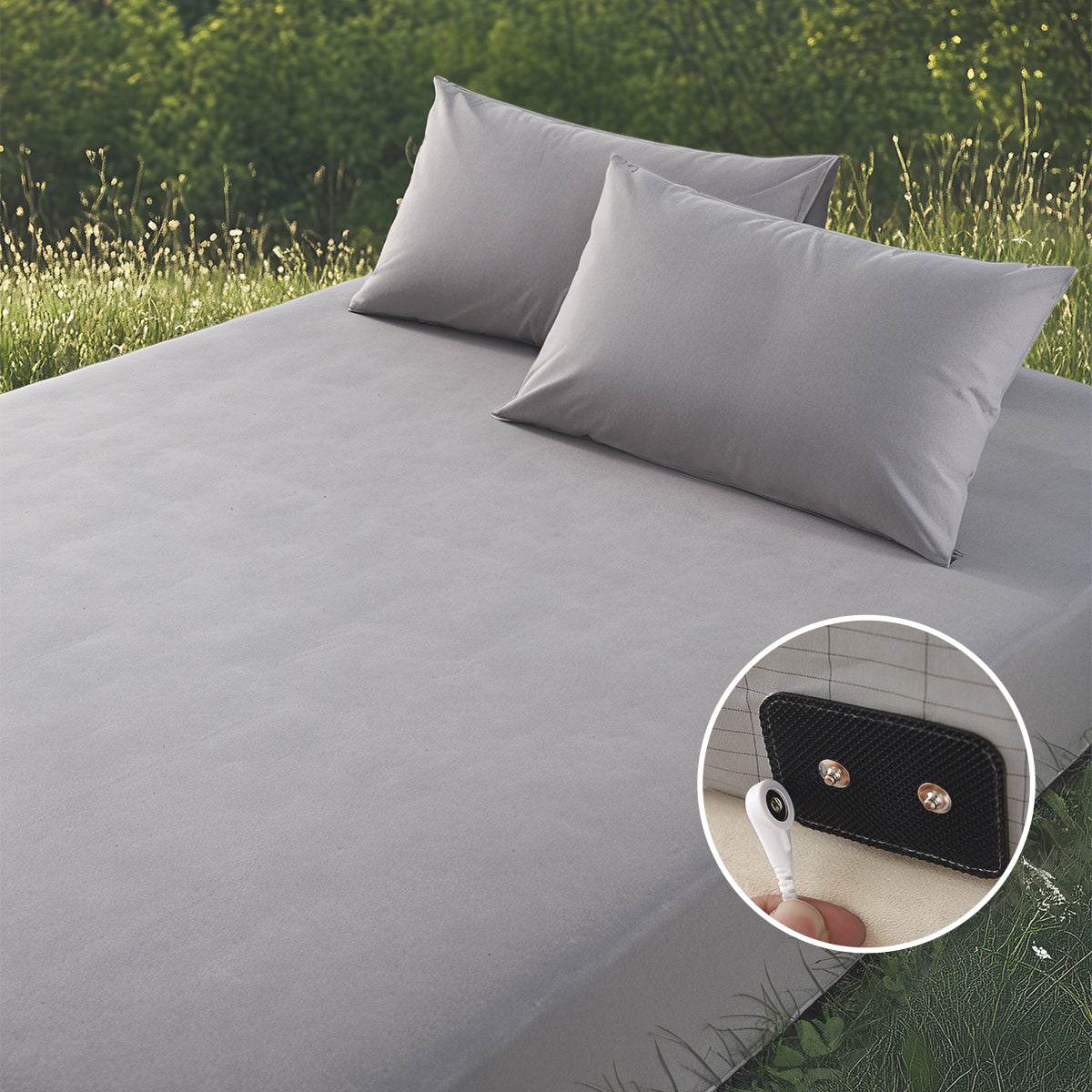5 Simple Steps: How to Clean Your Grounding Sheet Correctly
Grounding sheets need special care because of the conductive threads they contain. Regular cleaning helps keep your sheet working properly and lasting longer. This guide covers the right way to clean your grounding sheet to maintain both cleanliness and conductivity. The simple steps outlined below protect the special materials in your sheet while keeping it fresh and effective.

Why Cleaning Your Grounding Sheet Requires Specific Care
Silver threads that conduct electricity make grounding sheets different from standard sheets. In order to keep working properly and avoid damage, these special threads need to be cleaned in a certain way.
Body Oils and Lotions Block Conductivity
Static sheets work because they have silver threads in them. They can stop working if they are not cleaned properly, but standard sheets don't. The sheets get dirty over time from body oils, sweat, and skin care products. It makes a layer that stops the sheet from conducting electricity, which makes it less useful or even useless.
Harsh Detergents and Heat Damage Silver Threads
Grounding sheets can be damaged by everyday cleaning tools. Clothes softeners leave a film that stops the silver threads from conducting electricity, and bleach can break them down. You can also damage the threads with high heat from multiple washing or drying. The silver threads will stay in good shape and your sheet will last longer if you clean it gently.
What You Need to Clean Your Grounding Sheet
Right cleaning supplies are essential for maintaining your grounding sheet's conductivity and extending its life. Gather the following specific items before you start cleaning to protect the delicate silver threads and ensure proper care.
Required Cleaning Supplies:
- Mild Liquid Detergent: Use a clear, unscented detergent without bleach, chlorine, fabric softeners, whiteners, or oils. Detergents for delicate fabrics or sensitive skin work best.
- Warm Water (105°F/40°C): This temperature removes body oils without damaging the silver threads. Never use hot water.
- Gentle Washing Method: Either use a washing machine with a gentle cycle or hand wash in a clean basin.
- Air Drying Option: A drying line or clothes rack is best for preserving conductivity.
- Low Heat Dryer (if needed): If you must use a dryer, only use the "air fluff" or lowest heat setting.

Useful Extra Items:
- Gentle Stain Remover: For spot cleaning, use products safe for silver and delicate fabrics.
- Conductivity Tester: A multimeter can check if your sheet is still working properly after washing.
-
Soft Cloths: Microfiber cloths help with gentle handling and spot cleaning. Having the right cleaning supplies ready before you start will make the cleaning process easier and help maintain your grounding sheet's conductivity. The careful selection of these items is just as important as the washing method itself.
5 Simple Steps for Cleaning Your Grounding Sheet
The silver threads on your grounding sheet will continue to work well as long as you clean them properly. With these five steps, you can take care of the special needs of conductive bedding that normal sheets don't have.
Step 1: Unplug the Grounding Cord First
Take the grounding wire off of both the sheet connector (usually a snap) and the wall outlet before you wash it. This keeps the conductive system safe and stops any electricity problems. While you clean the cord, keep it away from water.
Step 2: Use Gentle Washing Methods Only
Hand Washing: Fill a clean basin with warm water (105°F/40°C). Add a small amount of mild detergent and dissolve completely. Soak the sheet for a few minutes, then gently swish it around. Never scrub, twist, or wring the fabric as this can break the silver threads.
Machine Washing: Select the "gentle" or "delicate" cycle with warm water. Wash the sheet alone or with other delicate items that won't damage it. Avoid washing with heavy items or anything with zippers or hooks. A mesh laundry bag provides extra protection.
Step 3: Rinse All Soap Completely
Hand Washing: Drain the soapy water and refill with clean, warm water. Gently agitate to remove detergent. Repeat 2-3 times until water runs clear. Some manufacturers recommend a final rinse with 1/4 cup white vinegar (check your product instructions).
Machine Washing: Use the "extra rinse" cycle if available to ensure all detergent is removed.
Step 4: Dry Carefully to Protect Silver Threads
Air Drying (Most Recommended): You can hang the sheet on a string or a rack inside. Spread it out all the way to dry evenly. Stay out of strong, intense sunlight for long periods of time. Over time, this can damage fabric.
Tumble Drying (Low Heat Only, If Necessary): To dry your clothes, only use the "air fluff" or lowest heat setting if you have to. Check often, and take it off while it's still a little damp so it can dry naturally. Dryer sheets and medium or high heat should never be used.
Step 5: Reconnect Only When Completely Dry
Before putting the grounding line back on, make sure your sheet is completely dry. Using a wet sheet could hurt performance and could even be dangerous. After it's dry, put the snap connector on the line and plug it into a grounded outlet to keep using it.
What NOT to Use When Cleaning Your Grounding Sheet
While following the proper cleaning steps is important, knowing what products to avoid is equally crucial. These common laundry products can destroy the conductive properties of your grounding sheet by damaging the silver threads.
❌ Bleach (Any Type)
Bleach corrodes silver threads on contact. Both chlorine and oxygen bleaches (including "color-safe" versions) will permanently damage the conductivity. This damage cannot be fixed.
❌ Fabric Softeners
Softeners coat fabrics with a waxy film that also covers the silver threads. This coating blocks conductivity and makes your grounding sheet stop working.
❌ Brightening or Whitening Detergents
Regular detergents with optical brighteners or whitening agents leave residues on silver threads that reduce conductivity. Use only simple, mild detergents without these additives.
❌ Strong Chemical Cleaners
Harsh detergents and degreasers can damage both the fabric and the silver threads. They're too aggressive for the delicate conductive materials in your sheet.
❌ Detergents With Oils
Many "natural" detergents contain essential oils like lavender or coconut oil. These oils leave residues on silver threads similar to body oils, blocking conductivity over time.
❌ Dry Cleaning
The chemicals used in dry cleaning will damage both the fabric and the silver threads. Never take your grounding sheet to the dry cleaner.
❌ Medium or High Heat Drying
Higher heat settings make silver threads brittle and can break them. This permanently reduces conductivity. Always air dry or use only the lowest heat setting on your dryer.
How Often Should You Clean Your Grounding Sheet?
You should clean your grounding sheet every 1-2 weeks. This regular cleaning schedule is recommended by most manufacturers to remove body oils and sweat that build up on the silver threads and block conductivity.
When to Adjust Your Cleaning Schedule:
- Heavy Sweating: If you sweat a lot during sleep, increase to weekly washing instead of biweekly to prevent rapid buildup on the conductive fibers.
- Skin Products: Using lotions or oils before bed requires washing every 5-7 days, as these products transfer more readily and can quickly coat the silver threads.
- Personal Preference: If you typically wash regular sheets weekly, maintain the same schedule for your grounding sheet to match your hygiene standards.
- Hot Weather: During summer or in humid climates, wash every 7-10 days instead of waiting a full two weeks, as higher temperatures cause more perspiration.
Regular Washing Maintains Conductivity
Unlike some delicate items that last longer with less washing, grounding sheets actually need regular cleaning to work properly. An unwashed sheet quickly loses effectiveness as oils and sweat create an insulating layer over the silver threads. Weekly washing using the correct method is better than washing less often.
Signs Your Sheet Needs Cleaning:
- Changes in how you feel when using the sheet
- Visible soiling on the fabric
- Decreased conductivity (if you test it with a multimeter) Start with washing every 1-2 weeks and adjust based on your personal situation. The most important thing is following the proper cleaning methods to protect the conductive threads.

6 Extra Tips to Make Your Grounding Sheet Last Longer
Besides cleaning your GroundingTime grounding sheet regularly, these extra steps will help keep it conducting electricity and make it last longer.
Apply Skin Products Earlier
Apply oils or creams at least one to two hours before going to bed. So, the products have time to soak into your skin instead of moving to the sheet. If you have to use goods right before bed, you might want to wear light cotton pajamas, though this will weaken the grounding effect a bit.
Prevent Physical Damage
Take off your jewelry before bed, and keep your pet's claws clipped so that the conductive threads don't get caught. When you make your bed, be careful not to damage the sheet, especially where the grounding cord connects to the snap link.
Consider Pet Hair and Oils
Their fur and body oils will get on your sheets if they sleep on them. More often (every 5 to 7 days), and be careful that their claws don't damage the cloth or conductive threads.
Wash Separately When Possible
It's best to wash your grounding sheet by itself. You should only wash it with gentle, colorfast clothes that don't have lint if you have to. When you wash things that have been cleaned with bleach or fabric softeners, the leftovers can move to other clothes.
Test Conductivity Occasionally
If you want to make sure your sheet is still working, use a voltmeter to check the resistance (ohms). Touch different parts of the sheet with the other probe while connecting the first one to the snap link. Over time, a rise in resistance means that fibers are getting damaged or building up.
Store Properly When Not in Use
If you're going to store your sheet for the season, make sure it's clean and dry first. Leave it open in a cotton bag or in a laundry closet to let it breathe. Do not use plastic bags or containers that hold water. If you have more than one sheet, use them in different ways so that they wear out evenly.
Clean Your Grounding Sheet Properly!
It's easy and clear how to take care of your grounding sheet. Do the five steps for cleaning: disconnect, wash gently, rinse well, dry carefully, and rejoin when it's dry. Clean it every one to two weeks to get rid of sweat and oils that get in the way of electricity flow. Bleach, fabric softeners, and high heat can ruin silver threads, so stay away from them. These small steps will keep your sheet's conductivity and make it last longer, so it will keep working well.
